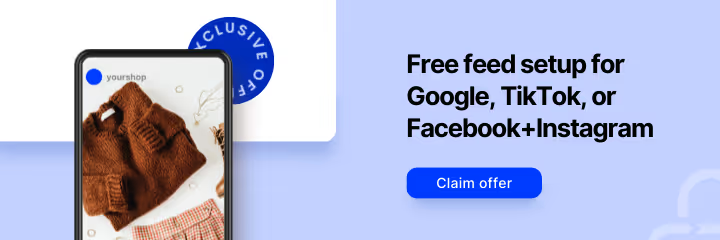When all of the pieces of an expertly-managed campaign align correctly, brands enjoy high ROI/ROAS and tons of traffic to their ecommerce stores—the obvious markings of campaign success.
But when your campaign isn’t doing so well (or could be doing much better), there’s usually a specific misaligned factor costing you piles of wasted spend money—and it may not be so obvious to you.
So to help you identify that source of discontent, I’ll be going over the 7 biggest mistakes that ecommerce advertisers make with their shopping campaigns.
Fixing these errors will help your campaign earn the highest returns on your investment with very little sweat work on your end.
1. Resting on Your Laurels
aka, You’re Not Worried About Your Shopping Ad Campaign Because It’s Performing Well
Shopping campaigns do well thanks to three main reasons:
- You have many search queries which are very specific to the individual product
- The price, reviews, promotions, and product image pre-qualify the searcher when they click on the ad
- The product landing page shows exactly what was promised in the ad
As long as you’ve done your due-diligence upfront to secure these points, you technically don’t have to do anything else to see positive results, right?
It’s this kind of thinking keeping so many ecommerce advertisers from reaching their maximum potential.
When you ignore your shopping campaign because it doesn’t fit into your regular optimization habits—or because it’s performing well enough on its own—you’re taking the lazy way out instead of improving your campaign’s ROAS.
One of my clients had a stellar shopping record with a 9x ROAS. They generated more than $20,000 in revenue just from shopping ads every month.
But, when I reviewed the stats, I noticed that their shopping campaign only accounted for 5.5% of the entire ad spend and 4.8% of the revenue in their account.
Those numbers seemed way off to me.
Ecommerce accounts generally have shopping campaigns that account for 20–30% of the spend/revenue, depending on their level of expansion into display and what specific industry they’re in.
So, we did a quick rewrite rule to add the category name from their website to the beginning of their product title. We then added the brand name to the end of their titles.
This one unbelievably simple tweak helped traffic shoot up 389%.
Stop ignoring your campaigns and start testing ways to improve upon your success.
2. Dumb Data
aka, You’re Still Submitting a Static Product Feed
Why are you still submitting a static data feed?!
I’ve seen a lot of wasted time over the years with AdWords, but nothing compares to the labor of managing static data feeds.
When you’re creating your data feed for shopping ads manually (i.e., you’re opening an Excel template and physically inputting your products, prices, links, etc.), you’re not only being inefficient, you may also be costing your store revenue.
The same goes for people who export their data feed, manually rewrite changes like titles and categories, and then upload it to the merchant center.
Stop. Just stop.
If you’re still living in the Data Feed Dark Ages, your efforts are more likely to result in low behind-the-scenes quality scores, disapproved products, and poor performance.
Not quite what you’re hoping for.
See, Google is very aggressive when it comes to incorrect data feeds.
If your data feed shows one price, but your website shows another, your product will be disapproved and no longer show up in shopping ads.
And, if your data feed has the wrong shipping info, your entire merchant center could be disapproved.
I had a client that decided to run their own merchant center prior to our working together.
When I was brought in after the second disapproval, I noticed that three particularly heavy products were exempt from the standard shipping pricing the company submitted in their data feed.
It took three weeks to get this client’s shopping ads started again after their improper shipping prices blunder.
By the time the mistake was caught, the damage had already been done.
Stale data feeds will kill your campaigns faster than almost any other mistake. So let technology help you out and a situation like this will (most likely) never happen to you. I highly recommend automatic data feed optimization from GoDataFeed (great for intermediates).
Research each of these to find the shopping feed platform best for your needs.
3. Store Titles, Not PLA Titles
aka, Using Non-Optimized (Store) Product Titles for Shopping Ads
It’s rare that an ecommerce stores exports their data feed with optimized product titles as the default.
Most ecommerce stores simply use the same product titles they use for the merchandise on their websites.
I typically run across product titles like:
- Clear Phone Case
- Tablet Cover
- Camera Tripod
The problem?
You’re wasting money actively looking to pay for clicks based on generic searches like phone case, tablet cover, and camera tripod. And generic searches don’t tend to convert high.
But adding more keywords to your product titles helps them show up for the right (read: profitable) search terms.
Let’s optimize those former titles:
- Clear Phone Case with Logo
- Imprinted Tablet Cover
- Compact Lightweight Camera Tripod
Andreas Reiffen experimented with product titles for his article on Google shopping campaign optimization to test this theory.
He altered the product title for a dress to include the keyword party dresses at the beginning of the title.

Image source: Search Engine Land
This resulted in an astounding response just from optimizing the product title:

Image source: Search Engine Land
Reiffen comments:
“Optimizing product descriptions and product categories within the product feed has no impact over traffic volume. Optimizing product titles within the product feed has a huge impact on traffic volume. Rewriting titles also allows traffic to be directed to certain products.”
A tool like GoDataFeed will help you create these general rewrite rules for your data feed so you’ll be exporting optimized product titles by default.
4. No Custom Labels
aka, You’re Not Taking Advantage of Custom Labels in Shopping Campaigns
Shopping campaigns benefit from the structure created by utilizing the Custom Labels feature.
When you segment your shopping campaign with labels, you can split it up based on:
- Price
- Active Promotions
- Most Popular
What’s the benefit of using a custom label like "Most Popular"?
Let’s say your ecommerce store sells tablecloths for events.
Your shopping data feed includes all the sizes of the tablecloths you have available, such as:
- Small Round: 81”
- Large Square: 120”
- Medium Oval: 90” x 140”
- Large Rectangle: 90” x 160”
This is ideal for a shopping campaign because it matches very specific keywords with exactly what the searcher is hunting for.
But what happens when a searcher doesn’t have that information available?
An assistant may perform a generic search for event tablecloths or buy tablecloths online.
If you let Google decide which product to show based on a search like this, Google will rotate your products until it finds a winner with high-scoring CTR.
To speed up the process and save some of your budget, try using a custom label instead.
Let’s say you apply the "Most Popular" label to the most popular tablecloth size.
In this example, large rectangle tablecloths happen to be a hot seller, so we’ll apply the "Most Popular" custom label to all large rectangle tablecloth models.
Now you’ll create two campaigns:
- Most Popular Sizes
- Everything Else
Your Most Popular Sizes campaign creates a product filter based on what you chose for your custom label "Most Popular."
This campaign gets high priority and the Everything Else campaign bumps down to normal priority.
Take the process one step further and apply your most popular keywords as exact match negatives in the Everything Else campaign.
Following these two steps ensures that your shopping campaigns show your most popular products when generic searches are performed.
This gives your store the best chances of high CTRs and high search conversion.
5. No Device Optimization
aka, You’re Not Splitting Up Campaigns for Mobile, Tablet, and Desktop Segments
As Aaron Levy’s article,“Should You Create Device-Specific PPC Campaigns?”, so politely argues, segmenting your campaigns isn’t necessary, but you should definitely do it.
You may think it’s a waste of time if your campaigns have been doing well without segmentation, but splitting up your campaign into three distinct campaigns (one for each device segment) helps you:
Assess performance based on each device
Since we can’t expect desktop conversions to behave the same as those on mobile, we need to look at the numbers and feedback separately to understand them.
For example, high-value and complex items convert terribly on mobile devices (think: beds, grills, etc.) whereas lower-valued products convert pretty well (like charging cables, headphones, etc.).
Adjust bids
Each device behaves differently depending on the location, hour, and day so you’ll need to bid differently and update each device accordingly.
I cover the practical approach to splitting up your campaigns for different devices in another blog post if you’re looking for a deep focus on the topic.
You’ll want to understand this point because it feeds directly into our next.
6. Lack of Segmentation
aka, Pausing Low-ROI Campaigns/Product Groups Without Reviewing Your Segments First
Certain searches convert better on mobile devices than they do on desktops—and vice versa.
To skip segmenting your campaign means you’d miss these device-specific insights.
Mobile device conversions can depend on a number of factors, such as your:
- Website’s mobile friendliness
- Product’s fit for mobile purchase
- Typical buying funnel
- Number of repeat customers (repeats create an account for easy checkout)
As we discussed in our previous section, people rarely purchase an item like an outdoor grill from a mobile device, but they have no problem making smaller purchases on-the-go.
While your mobile conversions may be low for specific products, they may still drive relevant traffic to aid your desktop conversions.
Always review each device segment before you pause anything.
7. Lopsided Budget
aka, You’re Not Spending Your Budget Allocation Where it Matters
Campaigns are your oyster when there’s an unlimited budget in your pocket.
But since most of us are limited by finite budgets, we’re forced to concentrate on strict, ruthless budget allocation.
Say you’re running three campaigns under your budget’s umbrella:

From the data in this table, we notice that we’re getting 315 conversions for a total spend of $15,350.
Judging by conversion rates, we see that Campaign 2 leads with a conversion rate of 12%; Campaign 1 runs behind at 5%; and Campaign 3 pulls in the least even though it costs the most.
So, what if we allocate more budget towards campaigns 2 and 1?
This simple diversion increases spend performance without doing anything else as you’ll see in this table:

We’ve increased conversions by 149% while also decreasing costs by 14%.
All from cutting a campaign that turned into a budgetary black hole.
We didn’t have to write any ads or research any new keywords to get those stats.
We literally just switched around a few numbers in less time than it takes to get a fancy coffee at your local brew shop.
Start Fixing these Mistakes Yesterday
Each of these 7 mistakes has the potential to significantly and negatively impact your conversions and ROAS.
But I know you’re busy, and you probably can’t correct all these errors today.
So, if you’re still messing around with a static data feed, find a data feed tool to optimize your campaign and monitor your feed for expensive errors. If you do nothing else, do this.
If your campaign isn’t segmented for mobile devices, get started on that ASAP as well.
Go through your account with a copy of the mistakes this post and you’ll be amazed by how many (not so obvious) oversights your campaign may be guilty of committing.






%20).webp)